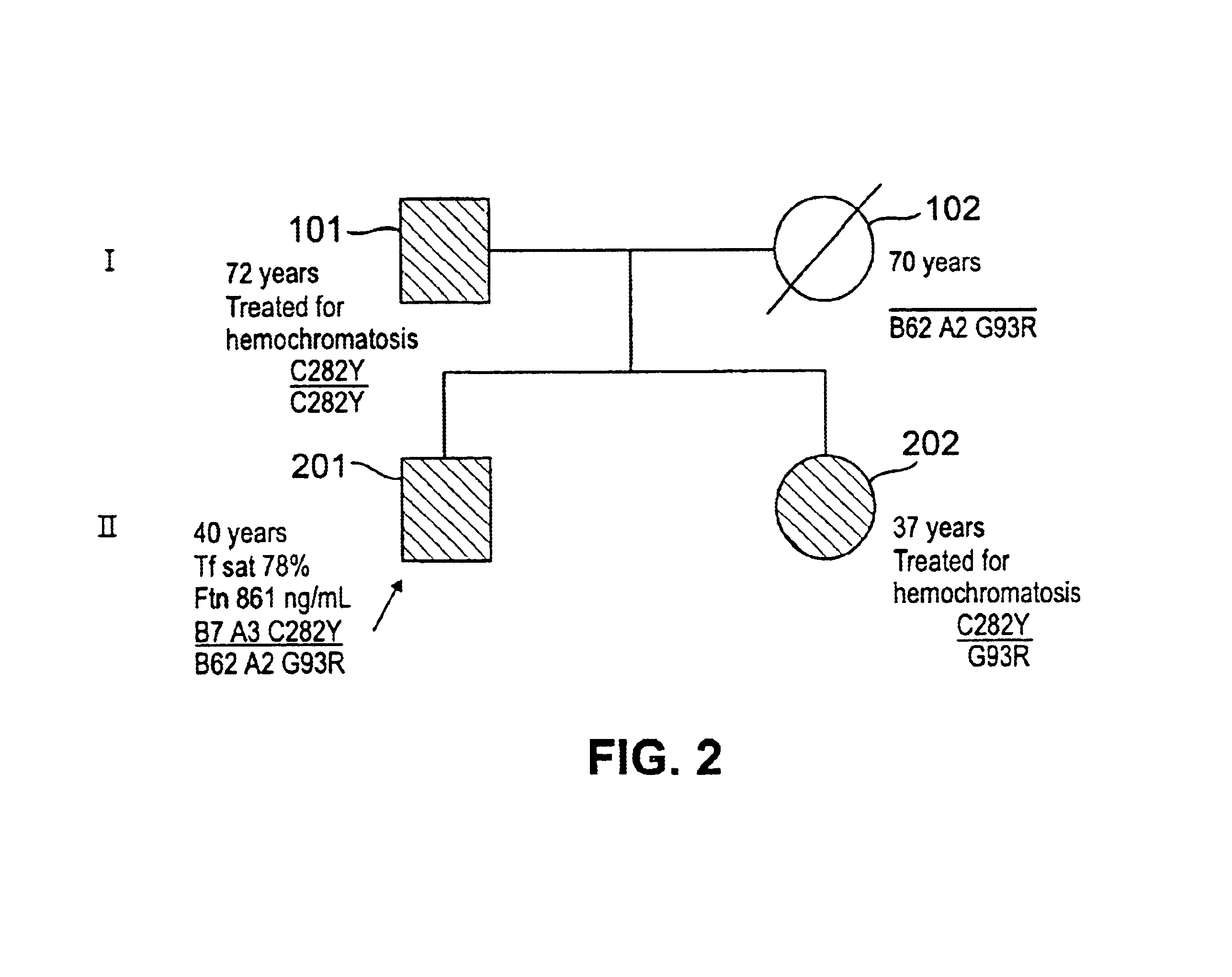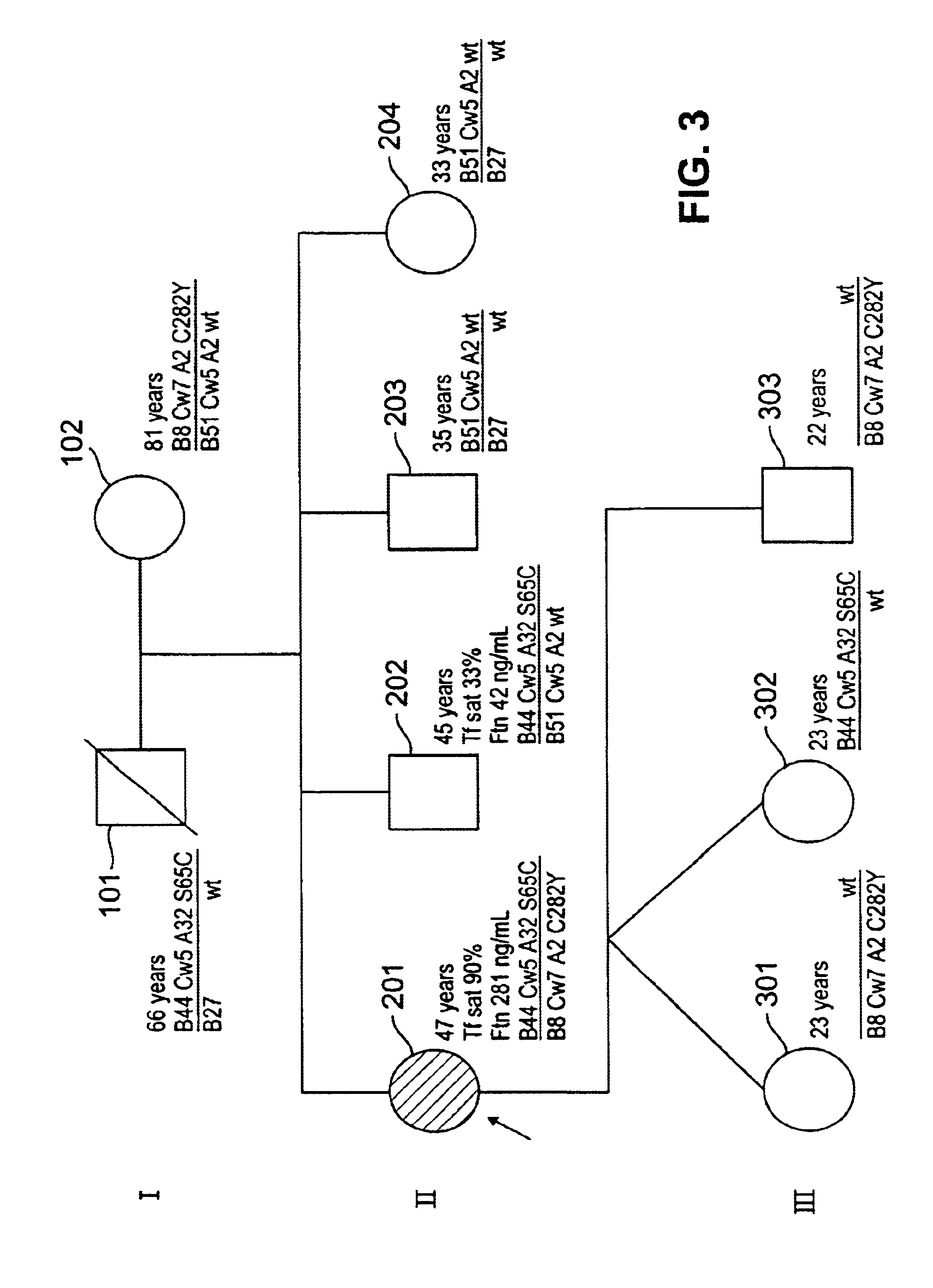Mutations associated with iron disorders
- Summary
- Abstract
- Description
- Claims
- Application Information
AI Technical Summary
Benefits of technology
Problems solved by technology
Method used
Image
Examples
example 2
HFE Gene Analysis
[0043]PCR amplification was used to detect mutations. Genomic DNA was prepared from peripheral blood buffy coat or saliva using the QIAmpBlood Kit (QIAGEN, Valencia, Calif.) or FTA Paper and FTA purification reagent (Fitzco Inc., Maple Plain, Minn.), respectively. Fragments were amplified from genomic DNA using eLONGase (Life Technologies, Gaithersburg, Md.) or HotStarTaq DNA polymerase (QIAGEN, Valencia, Calif.). Primers used to amplify each exon are shown in Table 3.
[0044]
TABLE 4Human HFE genomic DNA(SEQ ID NO:27; GENBANK ® Accession No. Z92910)1ggatccttta accgaggaga ttattatagc cggagctctg aagcagcaat ctcagttctt61gtgatagtga gcaaagaact acaaactaac accaaaatgc aagcttaaag caaagtttat121tgaagcacaa taatacactc tgagggacag cgggcttatt tctgcgaagt gaactcagca181cttctttaca gagctcaagg tgcttttatg gggtttgtgg ggaggagttg aggtttgggc241tgtatctgag tgacaggatg atgttatttg attgaagttt atagctatac aatctaaaat301taaactgtgc atggtcttac ctataatttg ttaagaaaag cctcccaggg atgggggggc361aaaactgtat gtaaattc...
example 3
Characterization of Probands
[0050]The mean age of the twenty probands was 44±11 years (range 27-62 years); thirteen (65.0%) were men and seven (35.0%) were women. Eleven had iron overload. One had hepatic cirrhosis, two had diabetes mellitus, four had arthropathy, and two had hypogonadotrophic hypogonadism. One proband also had hereditary stomatocytosis, another had beta-thalassemia trait, a third had ethanol intake >60 g daily, and a fourth had porphyria cutanea tarda. No proband had evidence of excess oral or parenteral iron intake, or of viral hepatitis B or C. At diagnosis of hemochromatosis, evaluation for common HFE mutations revealed that eleven probands were C282Y heterozygotes, five were H63D heterozygotes, and four did not inherit C282Y or H63D.
[0051]The mean age of the initial 176 control subjects was 52±15 years (range 18-86 years); 79 (44.9%) were men and 97 (55.1%) were women. There was no significant difference in the mean ages of men and women. Frequencies of HFE gen...
example 4
Identification of Novel HFE Mutations in Hemochromatosis Probands
[0053]The following novel mutations (missense mutations) were identified in probands 1 and 2: exon 2, nt 314T→C (I105T), and exon 2, nt 277G→C (G93R), respectively (Table 7; FIGS. 1 and 2). Probands 3 and 4 had a S65C mutation The S65C mutation has been observed in hemochromatosis patients but has not been deemed to be indicative of a disease state. In contrast, the data presented herein indicate that the S65C mutation is diagnostic of a disease state. This result is surprising in view of earlier observations. Other than C282Y or H63D, no HFE exon mutations were detected in the remaining sixteen of the twenty probands (Table 6). Nine probands were heterozygous for a base-pair change at intron 2, nt 4919T / C (SEQ ID NO:27); two probands were homozygous for this base-pair change. Heterozygosity for a base-pair change in intron 4 (nt 6884T→C) was detected only in probands 3 and 4, both of whom also inherited S65C. One prob...
PUM
| Property | Measurement | Unit |
|---|---|---|
| Fraction | aaaaa | aaaaa |
| Fraction | aaaaa | aaaaa |
| Fraction | aaaaa | aaaaa |
Abstract
Description
Claims
Application Information
 Login to View More
Login to View More - R&D
- Intellectual Property
- Life Sciences
- Materials
- Tech Scout
- Unparalleled Data Quality
- Higher Quality Content
- 60% Fewer Hallucinations
Browse by: Latest US Patents, China's latest patents, Technical Efficacy Thesaurus, Application Domain, Technology Topic, Popular Technical Reports.
© 2025 PatSnap. All rights reserved.Legal|Privacy policy|Modern Slavery Act Transparency Statement|Sitemap|About US| Contact US: help@patsnap.com



